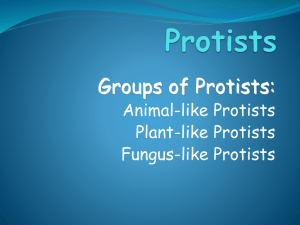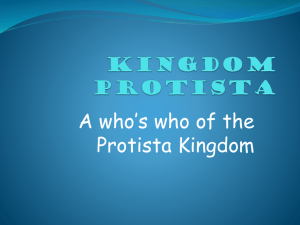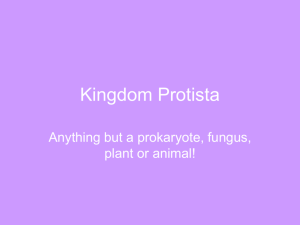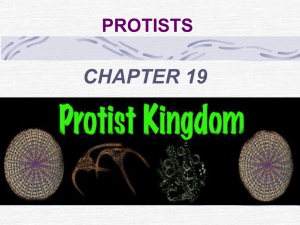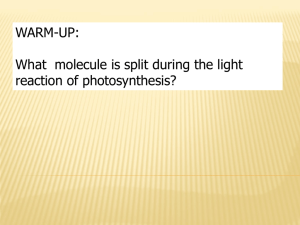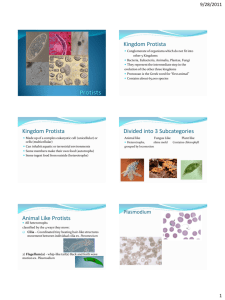Protists The World of Protists: Animal-like Protists Plant-like Protists
advertisement
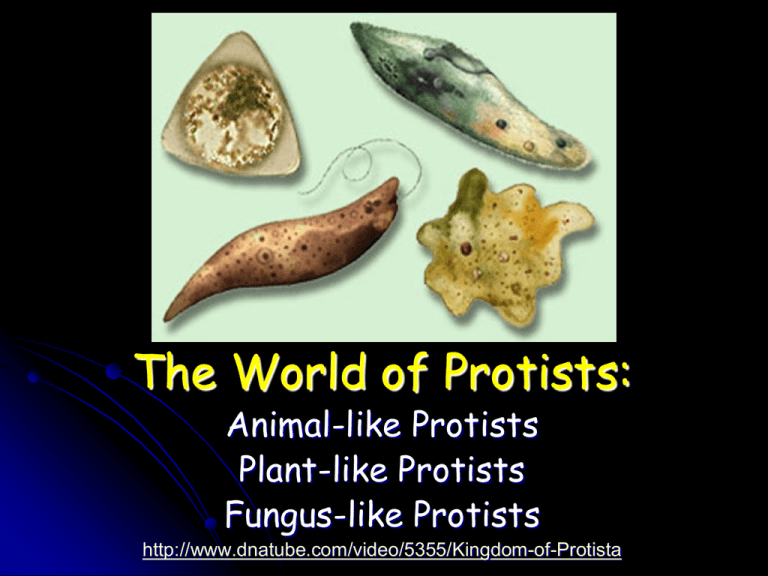
Protists The World of Protists: Animal-like Protists Plant-like Protists Fungus-like Protists http://www.dnatube.com/video/5355/Kingdom-of-Protista Protist Diversity 200,000 species come in different shapes, sizes, and colors All are eukaryotes – have a nucleus and membrane-bound organelles Protozoans Animal-like Protists Protozoans Unicellular – made up of one cell Heterotrophs – they eat other organisms or dead organic matter Classified by how they move (locomotion) Sub-groups of Protozoans Amoebas Flagellates Ciliates Sporazoans Amoebas AKA “The Blobs” No cell wall Move using pseudopods – plasma extensions Engulf bits of food by flowing around and over them Amoebas in Action… http://www.dnatube.com/video/1451/Largeactive-amoeba http://www.animalplanet.com/tvshows/monsters-inside-me/videos/the-braineating-amoeba.htm Flagellates AKA “The Ones with Tails” Use a whip-like extension called a flagella to move Some cause diseases Ciliates AKA “The Hairy Ones” Move cilia using tiny hairs called https://www.youtube.com/watch?v=Uvs5c OJYw7U Sporazoans AKA “The Parasite” Non-motile - Do not move Live inside a host One type causes malaria Plasmodium vivax (causes malaria) Algae Plantlike Protists What are Algae? Multicellular – made of more than one cell Photosynthetic – make their own food No roots, stems, or leaves Each has chlorophyll and other photosynthetic pigments Sub-groups of Algae Euglenoids Diatoms Dinoflagellates Red, Brown, & Green Algae Euglenoids AKA “The Survivors” Aquatic Move around like animals Can ingest food from surroundings when light is not available Diatoms AKA “The Golden Ones” Have shells made of silica (glass) Photosynthetic pigment called carotenoids – give them a golden color Dinoflagellates AKA “The Spinning Ones” Spin around using two flagella Responsible for Red Tides Create neurotoxins that can kill animals/sometimes people Red Algae AKA “The…uh…Red Ones (duh)” Seaweeds Multicellular, marine organisms Have red and blue pigments Brown Algae AKA “The Brown Ones (You think?)” They have air bladders to help them float at the surface – where the light is. Green Algae AKA “Yeah, You Guessed it, The Green Ones” Most live in fresh water Can be unicellular or multicellular Live alone or in groups called colonies Fungus-like Protists Characteristics: All form delicate, netlike structures on the surface of their food source Heterotrophs - obtain energy by decomposing organic material Sub-groups of Fungus-like Protists Plasmodium Slime Molds Cellular Slime Molds Water Molds & Downy Mildews Slime Molds Live in cool moist, shady places where they grow on damp, organic matter Plasmodium Slime Molds Form plasmodium: a mass of cytoplasm that contains many diploid nuclei but no cell walls or membranes – its feeding stage Creeps by amoeboid movement – 2.5 cm/hour Plasmodium continued… May reach more than a meter in diameter Form reproductive structures when surroundings dry up Spores are dispersed by the wind and grow into new plasmodium Cellular Slime Molds In feeding mode, they exist as individual amoebic cells When food becomes scarce, they come together with thousands of their own kind to reproduce May look like a plasmodium Water Molds and Downy Mildews Live in water or moist places Feed on dead organisms or parasitize plants Fuzzy white growths
